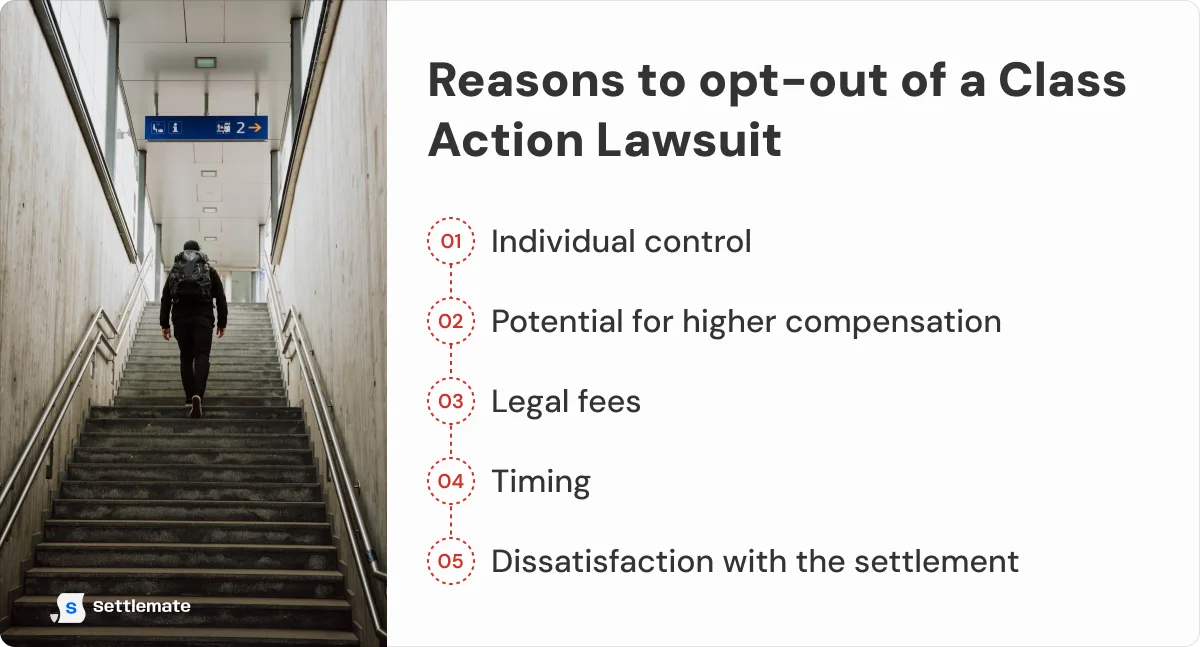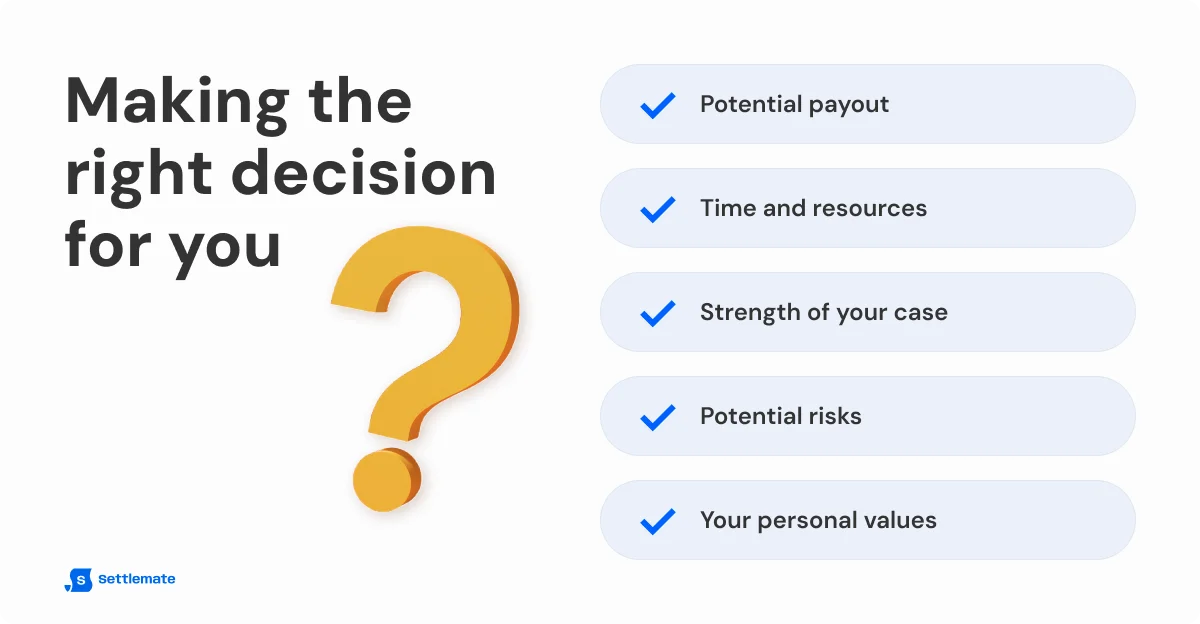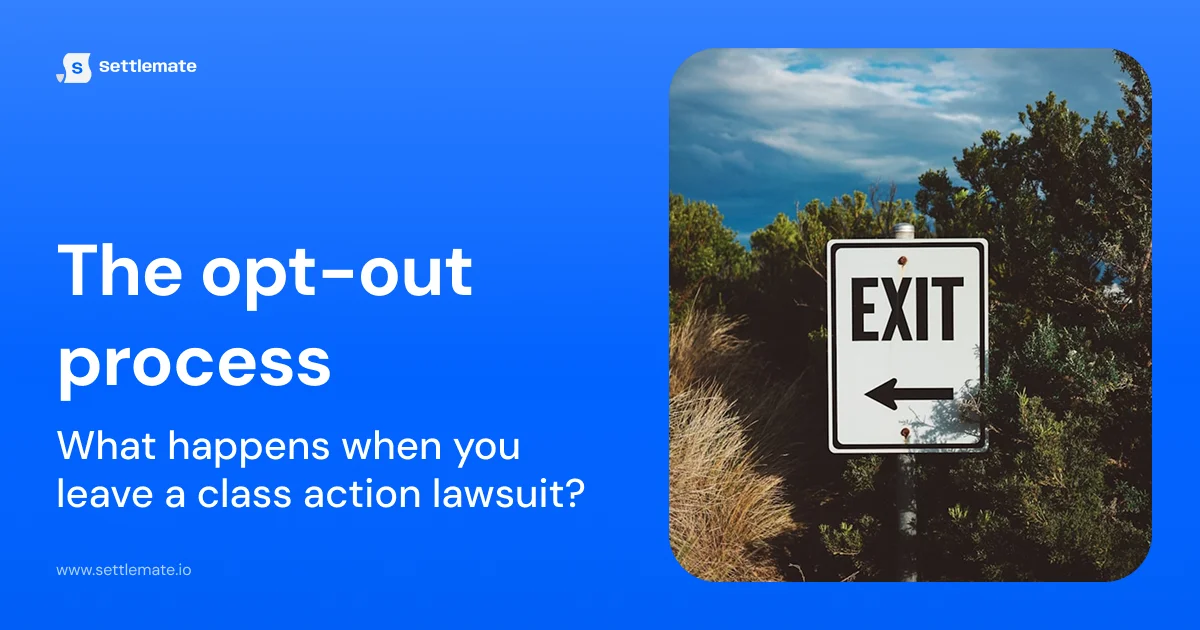Class actions deliver convenience: they move quickly, follow a standard process, and handle thousands of claims at once. You sign up, wait, and accept whatever payout the settlement delivers. For $50 or $100 claims, that works.
But what if you lost thousands? The “average payout” won’t make you whole. The system prioritises wrapping things up, not maximising your recovery. If you want real money or control over your case, you need another option.
That’s the opt-out process. It’s how you step away from the crowd and say, “I’ll fight this on my own terms.” Do it right, and you can sue for more; do it wrong, and you get nothing.
In this guide, we’ll explain exactly how the opt-out process works and what happens after you leave.
Key takeaways:
- Opting out gives you control but no class payout: Leaving the class means you won’t get a share of the settlement, but you keep the right to sue on your own and tailor the strategy to your unique losses.
- It makes sense if your damages are much higher than average: Class payouts are typically small and evenly divided. If you lost significantly more than most class members, opting out could help you recover closer to your actual losses.
- The process is strict and time-sensitive: Courts enforce deadlines without exception. You must follow the notice exactly, prepare an explicit exclusion request, and submit it before the cut-off date.
- Documentation protects you: Always keep airtight proof, such as certified mail receipts, courier tracking numbers, screenshots, or PDF confirmations.
- Settlemate helps you stay on top of deadlines and decisions: Missing a date or filing incorrectly can cost you money. Settlemate tracks class action notices, alerts you before opt-out windows close, and even pre-fills claim forms when you stay in.
What “opting out” really means
When a court certifies a class action for money damages under Rule 23(b)(3), it must send notice to everyone who qualifies as a potential class member.
That notice is your guide to understanding the case. It explains your rights, the deadlines you must meet, and the steps of the opt-out process. It also makes clear what happens if you do nothing. If you remain in the class, you are bound by the final judgment or settlement, even if you believe it does not fully cover your losses.
So, what does “opting out” actually mean? In practice, it is a simple choice: you notify the settlement administrator that you do not wish to participate in the class. You remove yourself before the court resolves the case. If you complete the opt-out process on time and in the correct way, three things follow:
- No payout from the class: You give up the right to receive money from the class settlement or verdict.
- You preserve your individual rights: You keep the option to bring your own lawsuit and seek damages independently.
- You are not bound by the class judgment: The outcome that applies to everyone else will not apply to you.
Courts and administrators sometimes refer to this as a “request for exclusion.” The phrase can be confusing, but it means the same thing as opting out.
It is also necessary to recognise that not every class action lawsuit includes this right. In cases certified under Rule 23(b)(2), which typically involve injunctive relief, such as stopping a company practice rather than paying damages, members generally do not have the option to opt out.
In short, opting out is the decision to give up a share of the class settlement in exchange for the chance to pursue your own case, on your own terms, and potentially recover more.
When opting out makes sense
For many people, staying in the class is the simplest way to receive some compensation. But there are situations where it may be smarter to step aside and pursue your own case.

Common reasons include:
1. Your losses are far higher than the average
Class action settlements typically divide funds among thousands or even millions of people. If your damages are significantly larger than the average class member’s, a pro rata payout may cover only a fraction of what you actually lost. Opting out allows you to pursue an individual lawsuit and prove the full extent of your losses in court.
2. You want control over your case
When you remain in a class action, the attorneys appointed as class counsel make strategic decisions for the entire group. You have no say in pleadings, discovery, or when and how to settle. By opting out, you regain control over the direction of your case and can decide when to negotiate, when to push forward, and what outcomes you are willing to accept.
3. You disagree with the settlement terms
Not all class settlements are created equal. Sometimes they undervalue the claims, offer only coupons or small cash payments, or allocate money unevenly among different groups of claimants. If you believe the proposed deal is unfair, opting out ensures the settlement does not bind you.
4. Your facts do not fit neatly into the class theory
Class actions depend on proving issues common to the group. Suppose your circumstances are unique, such as if you have dealt directly with the defendant or have defenses that the average class member does not. In that case, those differences may weaken your position within the class. Pursuing your own case avoids the risk of having your claim overshadowed by the class-wide narrative.
5. You prefer your own lawyer
You may already have legal representation or want to hire a specialist who focuses on your type of claim. Opting out gives you the freedom to select your own counsel and build a strategy tailored to your situation.
These choices reflect a core principle of due process. In Phillips Petroleum Co. v. Shutts (1985), the U.S. Supreme Court ruled that before a court can bind absent class members in a money-damages case, it must provide adequate notice and a genuine opportunity to opt out.
In other words, the Constitution protects your right to step aside if you believe the class action does not serve your best interests.
Real-world examples when opting out actually led to bigger individual recoveries
These cases demonstrate that opting out sometimes pays off in a significant way:
- WorldCom securities litigation: After WorldCom’s collapse, several institutional investors opted out of the class action and filed their own individual lawsuits. Their strategy succeeded: they recovered over $657 million, which in some instances was as much as 83 percent more than what they would have received via the class settlement.
- AOL/Time Warner merger litigation: When AOL merged with Time Warner, approximately 100 institutional investors opted out of the class action rather than remaining in the class. By pursuing individual claims, they pulled in $629 million, roughly ten times what class members would have gotten.
- Comverse Technology options-backdating litigation: A subset of investors opted out and resolved their claims for an all-cash amount at a significant premium to what they would have obtained as class members, avoiding the stock component embedded in the class settlement.
Step-by-step guide to the opt-out process
Think of the process as a checklist: miss a step and you may lose your chance to opt out. Follow it exactly as stated:
1. Read the official class notice carefully
The notice is your starting point. Courts require that it provide “the best notice practicable,” usually by mail, email, or both. It must explain:
- Your right to remain in the class or opt out
- The deadline for exclusion
- The method for submitting your request
- The effect of doing nothing (you remain bound by the class outcome)
Never skim this document. Every settlement has its own rules, and the notice will tell you precisely what counts as a valid opt-out.
2. Prepare a written request for exclusion
Most settlements require you to submit a short letter or form in which you clearly state that you wish to exclude yourself. At a minimum, include:
- Your full legal name and mailing address
- A clear statement asking for exclusion, with the case name and number
- Your signature
Some settlements provide online opt-out portals. Others require mail or email. Courts discourage unnecessary hurdles. The notice should only request the basic information needed to identify you.
Pro tip: Use the exact words suggested in the notice. For example: “I request exclusion from the [Case Name] Settlement.” Sticking to the template avoids arguments about whether your request was valid.
3. Send it on time using the approved method
Deadlines are firm. If the notice requires your request to be received by a specific date, mailing it late will not save you. If it needs a postmark, ensure you send it through a method that stamps the date. Administrators routinely reject late or incomplete requests.
4. Keep solid proof of submission
Do not rely on luck. If you send it by mail, use certified mail with tracking. If you submit online, save the confirmation page or email receipt. Screenshots and tracking numbers serve as your insurance policy in case the administrator later claims your request never arrived.
5. Look for confirmation
Many settlement administrators send a confirmation once your opt-out is processed. If you do not receive one, follow up. Use the settlement website or hotline listed in your notice to verify your status. It is your responsibility to make sure you are officially out of the class.
What happens when you opt out of and leave a class action lawsuit?
Opting out is a trade: you give up the class payout in exchange for control of your own claim.

Here’s what happens next, with essential rules and data points that put the decision in context:
1. You forfeit class money and releases
Once you exclude yourself, you do not receive any part of the class settlement or verdict, and the class-wide release and judgment do not bind you. You step outside that deal entirely.
Why this matters: Consumer class payouts can be small, and participation rates are often low. If you think your individual losses are meaningfully higher than the class average, forfeiting a small pro-rata share may be rational.
2. Your limitations “clock” restarts or resumes
Filing a proposed class action tolls the statute of limitations for absent class members’ individual claims while the class case is pending.
This is the rule from American Pipe & Construction Co. v. Utah. When you opt out, or the court denies class certification, the clock starts running again with whatever time remained when the class case began. Plan backwards from your original limitations period so you do not miss the filing window.
Two clarifications you should know:
- American Pipe tolling does not extend to new, follow-on class actions. In China Agritech, Inc. v. Resh, the Supreme Court held that tolling preserves only individual suits, not successive class actions.
- Application can vary by jurisdiction and claim type. Courts apply tolling rules with nuance, so confirm the timeline applicable to your state or federal claim before filing.
3. You now run your own case
After you opt out, you choose counsel, file your complaint, build your record, and negotiate a settlement on your terms. That control can translate into better outcomes for outlier losses, but it comes with cost, time, and litigation risk.
In securities matters, opt-outs have become more common in larger, complex cases.
4. Document everything and confirm your status
Keep airtight proof that you opted out:
- Certified mail receipts if you sent your opt-out letter by mail
- Courier tracking numbers, for FedEx, UPS, or other delivery services
- PDF copies of any online confirmation page
- Screenshots of submission acknowledgments or confirmation emails
- Date-stamped files - save them to a secure folder for quick retrieval
Then check the settlement site or hotline to verify that the administrator processed your exclusion. If your name still appears on the class list, follow up immediately to avoid later disputes about releases or judgment preclusion.
Note: This is a practical approach to risk management in today’s high-volume settlement administration environment.
5. Map your next 90 days
To convert your opt-out into a real recovery, move quickly:
- Retain counsel with experience in your claim type and jurisdiction.
- Calendar your limitations deadline based on American Pipe tolling math.
- Assemble evidence now: contracts, statements, emails, screenshots, device logs, and any notices you received.
- Decide your forum and theory: state vs. federal court, statutes, and damages model.
- Open to settlement? Early, well-supported demand letters can shorten the path to payment when your facts or damages exceed the class average.
The bottom line
- You give up: the class payout and the convenience of a turnkey distribution.
- You keep: the right to sue individually, control strategy and timing, and tailor settlement to your facts.
- You must: file on time after tolling ends, prove your case, and shoulder costs and risk.
How Settlemate helps you navigate the opt-out process and class action claims
Settlemate is a consumer fintech tool designed to streamline the process of finding and claiming settlement money you might otherwise miss. It’s not a law firm, and it doesn’t provide legal advice, but it offers operational support to ensure the paperwork, timing, and details don’t trip you up.
Here’s how Settlemate helps with opt-out decisions and class action claims:
- Instant eligibility matching: Settlemate scans open settlements and shows you which cases you qualify for. This approach helps you see the bigger picture quickly and weigh the trade-off between staying in the class or going through the opt-out process to pursue your own case.
- Deadline alerts you can rely on: Missing an exclusion or objection deadline can cost you your claim. Settlemate tracks these dates for you and sends real-time reminders so you always know when to act.
- Centralized notices and filings: For settlements where you choose to remain in the class, Settlemate can pre-populate and submit your claim forms with your authorization.
- Guardrails for important decisions: Settlemate provides organizational tools, not legal strategy. For high-value claims or complex opt-out decisions, it encourages you to consult an attorney. The platform’s role is to simplify, notify, and support you, enabling you to make timely, informed choices.
Stay one step ahead.
Settlemate makes the opt-out process simple while helping you capture every eligible settlement.









